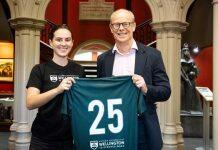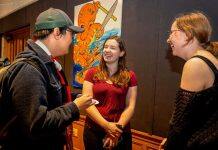Researchers developed a method that automatically creates slogans for products or services. The method could help people during a brainstorming session but at the same time, it shows how difficult it is to model creative work.


Inventing slogans to promote products and services can be tedious. Advertisements need to relate to the product, sound appealing and be creative, and all this is to be expressed in a short sentence. Researchers of computational creativity at the University of Helsinki are considering whether coming up with effective slogans could benefit from computational methods.
The researchers developed an algorithm that creates slogans for the desired target. The method is described in an article published in the journal Natural Language Engineering.
The method works in such a way that a person defines what qualities they want to include in the main concept (e.g. product or brand). The main concept can, for instance, be Helsinki, as in the example below. The system creates slogans for Helsinki and formulates them as descriptive expressions. The user specifies in advance what kind of a property (e.g. diverse) they want to highlight and associate with Helsinki.
We asked researcher Khalid Alnajjar to test what kind of slogans the system would suggest to the City of Helsinki. The system has only been used to generate English slogans but researchers have used the same method to produce poetry in Finnish. The slogans created by the system are also intended to be presented in such a way that the main concept does not have to be mentioned explicitly in the slogan.
Target message: Helsinki is a beautiful city
- See scenery. Travel together.
- Explore city. Wander together.
- Admire scenery. Relax truly.
- Your eye. Our countryside.
- Create story. Roam freely.
- For the people in the city of education.
Target message: Helsinki takes the environment into account
- Promote the commitment to planting.
- Grow the impact to Sustainability.
- Consider the value to plant.
- Remove rubbish. Impact inevitably.
- Smooth management. Grow together.
The system uses existing slogans of various products or services as templates. The system extracts words that produce suitable associations to the input by utilizing various linguistic resources. Furthermore, it considers related words to the main concept and the desired property.
We also tested the slogan generator for the University of Helsinki. You can find the slogans suggested to the input “university” at the end of the story.
Human labour is not in danger
The outputs of the generator demonstrate that a few examples are suitable for use as such. However, there are also some suggestions from which one could develop functional slogans.
Automated slogans are not replacing the work of human copywriters anytime soon.
“Creative tasks are often so open-ended by nature that they are difficult to solve with traditional artificial intelligence methods. If artificial intelligence methods also remain very open, the end result of the machine’s creative work is mainly nonsense”, Alnajjar says.
“As humans, we understand the world around us and its nuances much better than a machine, and we don’t make such mistakes. Advertising professionals could use this method to help them in brainstorming, but the system cannot replace human labour”, he continues.
The machine creates a metaphor
The researchers were interested in having the system use metaphors in slogans as well (“The University of Helsinki is an art” to indicate diversity), and not just introduce random words appropriate to e.g. the university.
To create metaphors, the researchers developed a special algorithm. The algorithm looks for concepts (theatre, art) that, when identified with its main word (university/Helsinki), indirectly convey the desired feature (diverse). In the generated slogans, the metaphor is also expressed indirectly in words related to art (skill, talented): “University of Helsinki – Skill of talented student”.
Researchers evaluated the metaphors and slogans developed by the system using an online crowdsourcing service. This way, the researchers received assessments from the volunteer testers not only of the language of the slogans but also of their relevance and overall quality. It also assessed how well automatic slogans were remembered and how well the metaphors created in them worked. For comparison, the researchers also asked for estimates of pre-existing, man-made slogans.
The result of the study is twofold: it is possible to create metaphors automatically, and the automation of slogans produced at least one in all the tasks tested that could work in proper use.
Human creativity matters
Khalid Alnajjar finds the concept of computational creativity interesting in all its challenges.
“Computers help us understand our own creativity. The machine can also help us with creative work such as creating music, paintings or slogans. I believe that in the future, computers can create increasingly customized marketing messages that allow people to find the best deals on the products or services they are looking for”, Alnajjar says.
Publication: Alnajjar, K., & Toivonen, H. (2020). Computational generation of slogans. Natural Language Engineering, 1-33. doi:10.1017/S1351324920000236







































